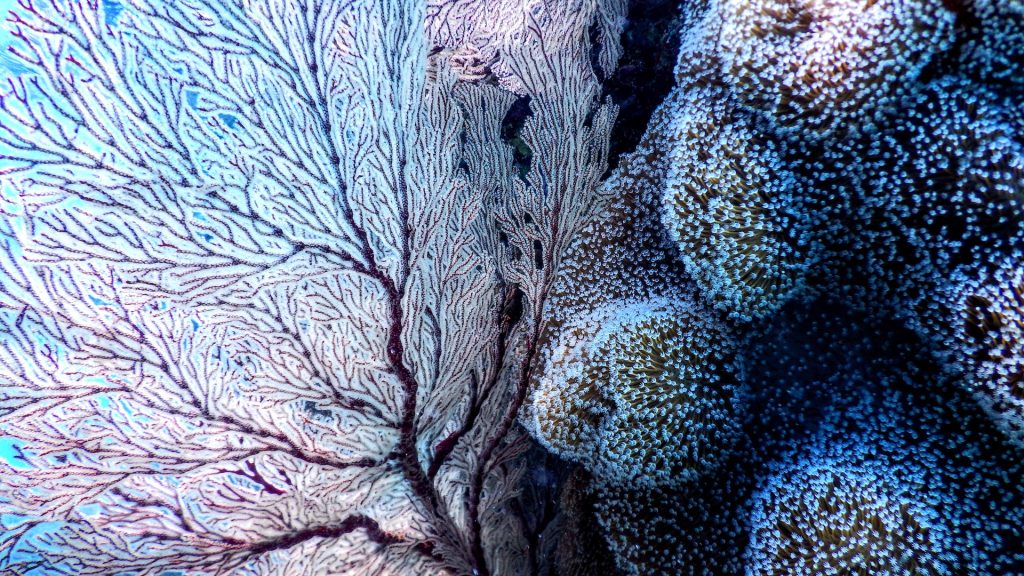Beneath the crystal-clear waters of our world’s oceans lies a breathtaking spectacle – coral reefs. These vibrant underwater cities are teeming with life, color, and a delicate balance of ecosystems. In this blog post, we will dive deep into the mesmerizing world of coral reefs, exploring their formation, significance, and the urgent need to protect these invaluable marine ecosystems.

Coral Reefs: Nature’s Underwater Masterpieces
Coral reefs are vast underwater structures composed of millions of tiny organisms called coral polyps. These polyps, related to sea anemones and jellyfish, build intricate limestone skeletons, which collectively form the foundation of a coral reef.
A Burst of Color: The Coral Polyp’s Symbiotic Relationship
One of the most astonishing aspects of coral reefs is their vibrant colors, which come from a mutualistic relationship between coral polyps and photosynthetic algae called zooxanthellae. These algae live within the polyps and provide them with oxygen and organic nutrients, while the polyps offer protection and access to sunlight for the algae.
The Coral Building Process: Slow and Steady
Coral reefs are not built overnight. In fact, they grow at an astonishingly slow rate, often as little as one to three centimeters per year. Over thousands of years, layer upon layer of coral skeletons accumulate, forming massive structures, such as the Great Barrier Reef off the coast of Australia.
The Diversity of Coral Reefs: A Biodiversity Hotspot
Coral reefs are often referred to as the “rainforests of the sea” due to the astonishing diversity of marine life they support. These underwater ecosystems are home to a staggering array of species, including fish, sponges, mollusks, sea turtles, sharks, and many more. In fact, about 25% of marine species depend on coral reefs at some point in their life cycle.
Ecosystem Services: The Value of Coral Reefs
Coral reefs offer a wide range of invaluable ecosystem services:
- Biodiversity Hotspots: As mentioned earlier, coral reefs host a myriad of species, contributing to overall biodiversity and ecological balance.
- Economic Benefits: Coral reefs support fisheries, tourism, and coastal protection, providing livelihoods and economic opportunities for communities in the vicinity.
- Food Resources: Fish and other marine species that live on and around coral reefs are essential food sources for millions of people worldwide.
- Coastal Protection: Coral reefs act as natural barriers, reducing the impact of storms and protecting coastlines from erosion.

Coral Bleaching: A Looming Threat
Despite their vital role in marine ecosystems, coral reefs face a grave threat – coral bleaching. This phenomenon occurs when coral polyps expel their zooxanthellae due to stressors such as rising sea temperatures, pollution, and ocean acidification. The loss of these colorful algae leaves the coral skeletons behind, turning the reefs white and making them susceptible to disease and death.
The Urgent Need for Conservation
Coral bleaching is a stark reminder of the urgent need to protect these precious ecosystems. Efforts are underway on various fronts:
- Marine Protected Areas: Establishing marine protected areas is crucial for conserving coral reefs and the life they support. These protected zones help reduce human impact on the reefs, allowing them to recover and flourish.
- Climate Action: Reducing greenhouse gas emissions to mitigate the impacts of climate change is essential. Lowering sea temperatures and curbing ocean acidification can help safeguard coral reefs.
- Sustainable Fishing Practices: Implementing sustainable fishing practices helps maintain the delicate balance of reef ecosystems, ensuring they continue to thrive.
- Coral Restoration: Scientists are researching and developing techniques to restore damaged reefs by growing and transplanting coral fragments.
The Wonder of Coral Reefs: A Legacy to Protect
Coral reefs are not only the jewels of the ocean but also an integral part of Earth’s ecological tapestry. Their stunning beauty, coupled with their vital ecological roles, make them worth celebrating and preserving. The continued survival of coral reefs depends on the collective efforts of individuals, communities, and nations to reduce stressors and take action to protect these underwater wonders.

Coral reefs, with their vibrant colors and incredible biodiversity, are truly wonders of the natural world. They are a testament to the interconnectedness of life in our oceans and a source of inspiration for scientists, divers, and nature enthusiasts worldwide. Yet, they face a critical moment in history, with the impact of climate change and human activity threatening their existence. By raising awareness and taking action, we can ensure that these underwater cities continue to flourish, leaving a legacy of breathtaking beauty and ecological vitality for generations to come.





